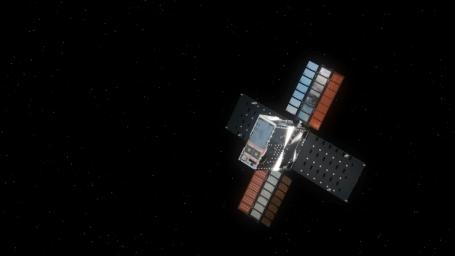This illustration shows NASA's Lunar Flashlight, with its four solar arrays deployed, shortly after launch. The small satellite, or SmallSat, launched Nov. 30, 2022, aboard a SpaceX Falcon 9 rocket as a rideshare with ispace's HAKUTO-R Mission 1. It will take about three months to reach its science orbit to seek out surface water ice in the darkest craters of the Moon's South Pole.
A technology demonstration, Lunar Flashlight will use a reflectometer equipped with four lasers that emit near-infrared light in wavelengths readily absorbed by surface water ice. This is the first time that multiple colored lasers will be used to seek out ice inside these dark regions on the Moon, which haven't seen sunlight in billions of years. Should the lasers hit bare rock or regolith (broken rock and dust), the light will reflect back to the spacecraft. But if the target absorbs the light, that would indicate the presence of water ice. The greater the absorption, the more ice there may be.
The science data collected by the mission will be compared with observations made by other lunar missions to help reveal the distribution of surface water ice on the Moon for potential use by future astronauts.
Lunar Flashlight is managed for NASA by the agency's Jet Propulsion Laboratory, a division of Caltech in Pasadena, California. Barbara Cohen, the mission's principal investigator, is based at NASA's Goddard Space Flight Center in Greenbelt, Maryland. Lunar Flashlight will be operated by Georgia Tech, including graduate and undergraduate students. The Lunar Flashlight science team is distributed across multiple institutions, including NASA's Goddard; the University of California, Los Angeles; Johns Hopkins University Applied Physics Laboratory; and the University of Colorado.
The SmallSat's propulsion system was developed by NASA's Marshall Space Flight Center in Huntsville, Alabama, with development and integration support from Georgia Tech. NASA's Small Business Innovation Research program funded component development from small businesses, including Plasma Processes Inc. (Rubicon) for thruster development, Flight Works for pump development, and Beehive Industries (formerly Volunteer Aerospace) for specific 3D-printed components. The Air Force Research Laboratory also contributed financially to the development of the Lunar Flashlight propulsion system. Lunar Flashlight is funded by the Small Spacecraft Technology program within NASA's Space Technology Mission Directorate.

 Planetary Data System
Planetary Data System












